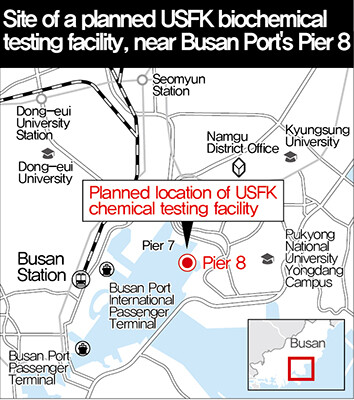hankyoreh
Links to other country sites 다른 나라 사이트 링크
Biochemical weapons experiments in the middle of a city of 3.5 million?

Busan Port’s Pier 8, which has been in operation since 1980, is located in the Gamman neighborhood of the city’s Nam District. Within just three kilometers of the pier there are many important public institutions and community facilities, including more than 20 schools, 20 to 30 apartment complexes, the United Nations Memorial Cemetery, and Busan Station. The North Port Redevelopment Project is also underway nearby.
As part of its JUPITR project, the US military is planning to set up a Chemical and Biological Weapons Laboratory, where experiments with such highly lethal agents as anthrax will be conducted. Equipment and personnel needed for the laboratory will arrive at the port by November of this year, and the lab is scheduled to begin operations next year.
Last December the Ministry of Defense and the US military revealed that, at bases in Seoul’s Yongsan district and Osan, Gyeonggi Province, US Forces Korea (USFK) have carried out at least 16 training experiments involving dead anthrax samples and one experiment with dead bubonic plague bacteria.
Civic groups in Busan are opposing the establishment of the Chemical and Biological Weapons Laboratory on Pier 8, voicing concerns about harmful effects on human life due to exposure to anthrax or other lethal biological agents that might accidentally be released to the outside in the course of experiments.
In May, more than 80 civic groups got together to form the Busan Citizens’ Action Committee Against Establishing a US Military Chemical and Biological Weapons Laboratory in Busan, which sent representatives to Seoul on July 6 in an effort to block the laboratory project. They boarded buses in front of the Busan Metropolitan Council at 7:30 am. Upon arrival in Seoul, they went to the US Embassy and the Ministry of National Defense to hold press conferences and deliver their letter of protest.
The letter calls for the JUPITR project be abandoned, saying, “When the United States conducts experiments with chemical and biological weapons on American soil, it does so in the middle of the desert. To carry out such dangerous experiments in the city of Busan, which has a population of 3.5 million, shows a complete lack of consideration for the lives and safety of its citizens. We will continue to fight against the establishment of a chemical and biological weapons laboratory until the plan is withdrawn.”
On July 4, the Action Committee sent the Busan Metropolitan City Government and the Busan Health and Environmental Research Center documents inquiring about whether they have assented to the JUPITR project and about the formation of a joint system of private and government observers to monitor it.
Kim Hee-seon, chair of the Joint Execution Subcommittee of the Action Committee, has said, “Ninety percent of those who inhale anthrax die within three days if proper measures are not taken immediately. Although the JUPITR project is intended as a preparation against potential biochemical attacks by North Korea, the important point here is that experiments are to be conducted using dangerous bacteria. We need to learn a lesson from what happened in the Soviet Union in 1979 when anthrax experiments resulted in 64 deaths.”
Mark Lippert, the US ambassador to South Korea, visiting Busan for an event in celebration of the 240th anniversary of American independence, attended a social gathering at Busan City Hall on July 5. When asked if he would meet with representatives of the Action Committee in Seoul on the July 6, he avoided any direct reference to issue of the JUPITR project, saying simply that he had nothing in particular to say to them.
By Kim Kwang-soo, Busan correspondent
Please direct questions or comments to [english@hani.co.kr]

Editorial・opinion
![[Column] Season 2 of special prosecutor probe may be coming to Korea soon [Column] Season 2 of special prosecutor probe may be coming to Korea soon](https://flexible.img.hani.co.kr/flexible/normal/500/300/imgdb/original/2024/0426/3317141030699447.jpg) [Column] Season 2 of special prosecutor probe may be coming to Korea soon
[Column] Season 2 of special prosecutor probe may be coming to Korea soon![[Column] Park Geun-hye déjà vu in Yoon Suk-yeol [Column] Park Geun-hye déjà vu in Yoon Suk-yeol](https://flexible.img.hani.co.kr/flexible/normal/500/300/imgdb/original/2024/0424/651713945113788.jpg) [Column] Park Geun-hye déjà vu in Yoon Suk-yeol
[Column] Park Geun-hye déjà vu in Yoon Suk-yeol- [Editorial] New weight of N. Korea’s nuclear threats makes dialogue all the more urgent
- [Guest essay] The real reason Korea’s new right wants to dub Rhee a founding father
- [Column] ‘Choson’: Is it time we start referring to N. Korea in its own terms?
- [Editorial] Japan’s rewriting of history with Korea has gone too far
- [Column] The president’s questionable capacity for dialogue
- [Column] Are chaebol firms just pizza pies for families to divvy up as they please?
- [Column] Has Korea, too, crossed the Rubicon on China?
- [Correspondent’s column] In Japan’s alliance with US, echoes of its past alliances with UK
Most viewed articles
- 1‘We must say no’: Seoul defense chief on Korean, USFK involvement in hypothetical Taiwan crisis
- 2AI is catching up with humans at a ‘shocking’ rate
- 3S. Korea “monitoring developments” after report of secret Chinese police station in Seoul
- 4The dream K-drama boyfriend stealing hearts and screens in Japan
- 5[Column] Can we finally put to bed the theory that Sewol ferry crashed into a submarine?
- 6[Editorial] Yoon cries wolf of political attacks amid criticism over Tokyo summit
- 7Doubts remain over whether Yoon will get his money out of trip to Japan
- 8[Photo] “Comfort woman” survivor calls on president to fulfill promises
- 9[Editorial] Was justice served in acquittal of Samsung’s Lee Jae-yong?
- 10Is N. Korea threatening to test nukes in response to possible new US-led sanctions body?